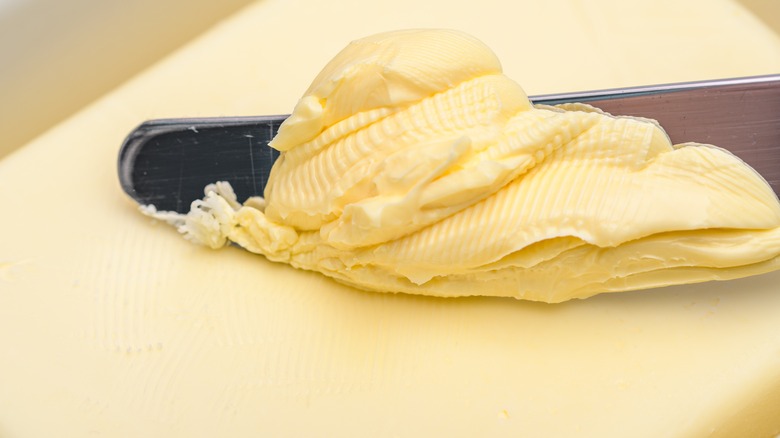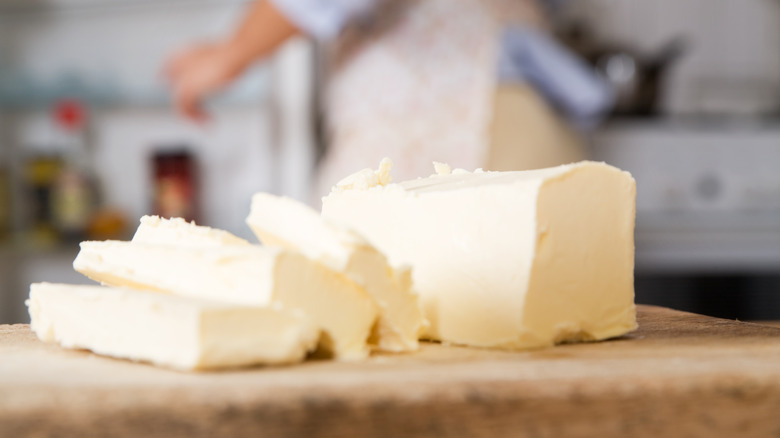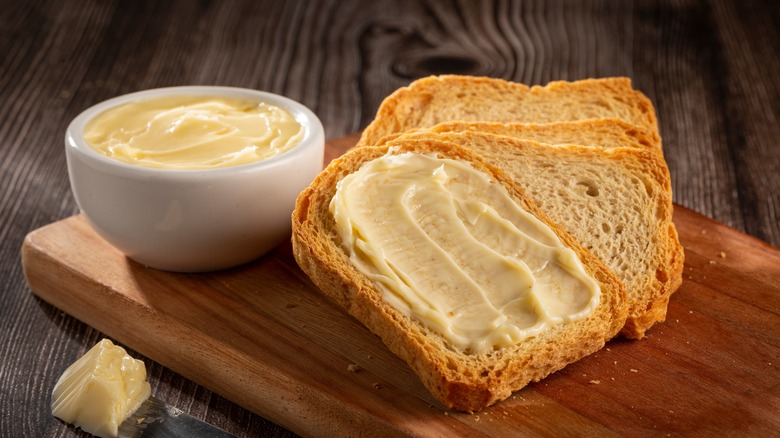When To Use Name-Brand Vs Generic Butter
Butter has remained a staple in most kitchens and on many dinner tables for countless decades. When used properly, this creamy dairy product infuses a rich, savory flavor that shines in baking, pan-frying, and even by itself as a spread on bread and rolls. But, with the U.S. Bureau of Labor Statistics reporting the price of many foods has skyrocketed in the past two years due to inflation, including the average cost of butter, some have been trying to battle the rising costs of living by ditching name-brand options for cheaper, generic alternatives.
This may seem like a problem for serious butter fans who are looking to save a few bucks while retaining quality, but you can actually swap out name-brand butter varieties for generic options in some cooking applications.
For example, making a cake or butter roast chicken are dishes where generic butter works. All of the savory undertones you'd normally taste in a fine butter would be masked by the other, more prominent ingredients in these recipes anyway, so generic butter should do just fine as a cheaper alternative in these cases. But, you'll want to keep name-brand butter for spreads and finishes like when slathering a baguette, since in those instances the flavors of the dairy product are meant to shine through.
Generic butter works well for just about everything
While taste can be subjective, generic butter tends to have muted flavors when compared to fancier variants; however, by itself, few people are able to taste the difference in quality. So unless you're doing a side-by-side comparison of how one version of this dairy product compares to the other, you shouldn't face any noticeable losses in taste and quality. This is doubly true when using generic butter for things like baked treats or mixed into goods with powerful ingredients, such as garlic, rosemary, and the like. You'll also save a lot more money by going generic, as some of the nicer name-brand butters go for twice the price.
While the exact ingredients of any butter brand can differ slightly from the rest, many people agree that the difference between generic and name-brand butter boils down to packaging. In fact, the U.S. Department of Agriculture grades all commercially available butters based on quality and flavor, with Grade AA ranking as the highest. Regardless of your price point, look for this label when you're out shopping for butter to avoid purchasing any low-quality variants.
Sure, there are some differences in taste based on a cow's diet (which is why Kerrygold tastes so darned good — wild roaming grass-fed cows produce tastier milk), but overall? Little difference — especially when looking at Grade AA butters.
Keep your butter stored in the fridge or freezer to make it last longer
Because the U.S. Department of Agriculture makes sure that all American butters have at least an 80% fat content, most generic brands do not differ much when it comes to texture or flavor. While most butters hover on the 80% mark, just a minimal increase (82%) in the fat percentage tends to separate the generic brands from the upscale European name brands. The increased butterfat tends to give these pricier variants a smoother, more pronounced mouthfeel, making them a favorite among butter lovers. However, there are plenty of American butters that also have a higher-than-usual fat percentage and feature lower prices — and generic brands are no exception.
Labels are once again your friend when shopping for generic butters with higher fat content, as many manufacturers advertise this information in their packaging. You'll also want to stay away from "light" generic butters, as these variants are just diluted with air, water, or artificial fillers, like lactic acid. Regardless of which type you choose, remember to take your butter's temperature prior to cooking, as this could also make or break your dish.



